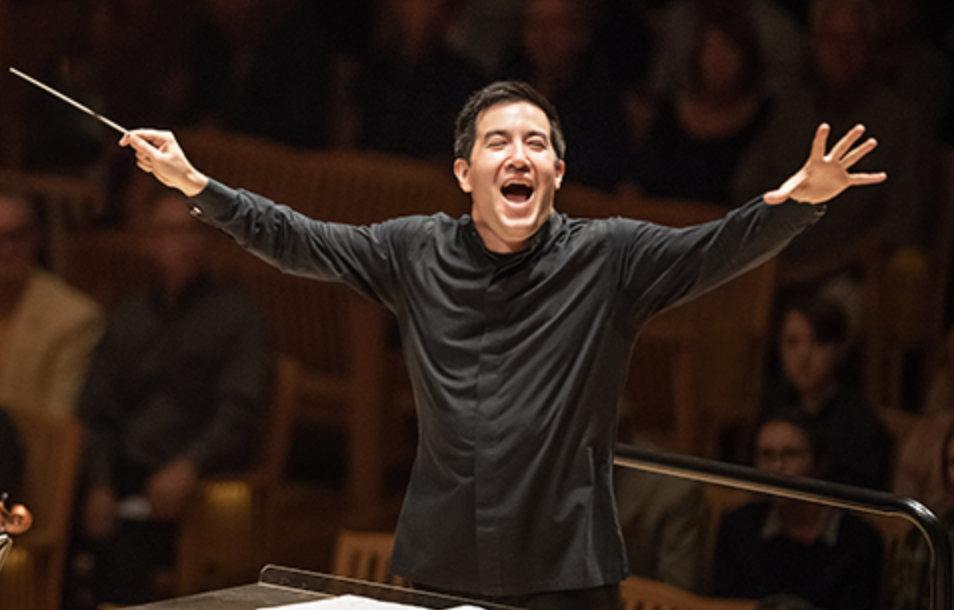|
Symphony
FROM THE NEW WORLD TO THE OLD WORLD
by Peter Lert
Saturday, June 14, 2025
Chamber
MC2 DUO RECITAL CLOSES 222'S SEASON
by Terry McNeill
Saturday, June 14, 2025
Choral and Vocal
CANTIAMO SONOMA'S LUSCIOUS A CAPELLA SINGING IN SEASON ENDING CONCERT
by Pamela Hicks Gailey
Sunday, June 8, 2025
Symphony
SRS SEASON ENDS WITH RESOUNDING TA-TA-TA-BANG
by Terry McNeill
Sunday, June 1, 2025
Symphony
YOUTHFUL VIRTUOSITY ON DISPLAY AT USO'S MAY CONCERTS
by Peter Lert
Saturday, May 17, 2025
Symphony
MYSTICAL PLANETS AND LIVELY GERSHWIN ORTIZ AT FINAL SRS CONCERT
by Peter Lert
Sunday, May 4, 2025
Symphony
VSO'S CONCERT MUSIC OF TIME, MUSIC OF PLACE
by Peter Lert
Sunday, April 27, 2025
VOCAL ELEGANCE AND FIRE AT THE 222'S RECITAL APRIL 26
by Pamela Hicks Gailey
Saturday, April 26, 2025
CANTIAMO SONOMA SINGS AN INSPIRED GOOD FRIDAY MOZART REQUIEM CONCERT
by Pamela Hicks Gailey
Friday, April 18, 2025
DRAMATIC SHOSTAKOVICH SYMPHONY CLOSES PHILHARMONIC'S 25TH SEASON
by Terry McNeill
Sunday, April 13, 2025
|
 |
 Conductor Francesco Lecce-Chong |
TITANIC SRS MAHLER SYMPHONY IN WEILL NOV. 5
by Terry McNeill
Sunday, November 5, 2023
The composer Gustav Mahler was reputed to say that a great symphony must encompass the entire world. That comment surely characterized the Santa Rosa Symphony’s Nov. 5 performance of the Mahler D Major in Weill Hall.
Over a long 58-minute second half the sprawling work from 1889 was passionately fashioned by Francesco Lecce-Chong, conducting without score, and at times the volume surpassed that of the Mexican Minería Orchestra in the same hall Oct. 20. It takes a big ensemble to perform the “Titan” Symphony, and the conductor marshaled more of what was needed – 8 horns, 7 contrabasses, 4 trombones and 4 trumpets, sometimes four flutes and a big red bass clarinet.
The bucolic sound that opened the first movement perfectly captured a vision of nature, spiced by soft fanfares from the oboes, horns and a cuckoo call, and finally ended with a huge sonorous climax. It was masterful playing, under tight control from Mr. Lecce-Chong. Solos by Meredith Brown (horn), and clarinetist Roy Zajac were elegant and carried perfectly above the rich sonic fabric. Mahler loves chirpy piccolo parts, and Stacey Pelinka provided them throughout.
The brief Scherzo (brief in comparison) came as a welcome sonic respite, as did Andy Butler’s contrabass solo that began the famous minor key funeral march movement. Here there was much impressive instrumental playing: hiccupping violins, mournful oboes, harp (Dan Levitan) and soft muted strings.
The conductor gave the slam-bang opening of the finale a sonic shock value that must have awakened many in the Sunday audience of 1,100 from the reverie of the solemn folk melody of the march. Mr. Lecce-Chong deftly highlighted the many contrasts of the often violent music that alternated with a beguiling lyrical melody in the middle. The horn section rose standing to blast out a heroic victory, capping a riveting 20-minute movement of splendid orchestral sound.
A standing ovation erupted with the conductor recognizing sections and then individual players. That said, Mr. Lecce-Chong was the singular hero of the afternoon with his singular performance conception of this demanding score.
In the first half two Gabrieli brass fanfares were heard, Canzon Noni Toni and Canzon Septimi et Octavi Toni, both arranged by SRS trombonist Bruce Chrisp. There were 12 instruments on the mostly empty stage, with some offstage, and the music was played at brisk tempos with heraldic fanfare.
The first performance of composer Clarice Assad’s “Play” for Orchestra featured the four-person Third Coast Percussion ensemble and was a 21-minute exploration of often humorous percussion effects glancing over the orchestra sound, that belied any musical significance. At the stage microphone the composer sang, vamped, giggled and narrated a story that was sporadically indistinctly heard at my balcony seat.
Responding to loud applause, the ensemble sans orchestra played a short marimba-laden encore, Watercolor Sun.
|

